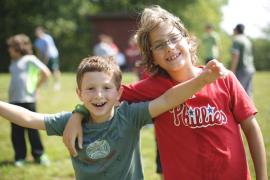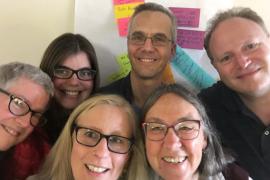You did it! You’ve checked all the boxes and hired a full team of staff for the summer — counselors, lifeguards, ropes experts, and everything in between. As spring fully begins its transition into summer, there’s one more major item on the checklist before the campers arrive: staff orientation. As camp professionals, we all know the importance of this critical period of time. It builds community, sets expectations, and teaches staff many of the skills and strategies they’ll use to be successful throughout the summer. And while much of our focus during orientation is on the task at hand, it’s also the best time to start thinking about the agenda for next year’s orientation. Here are 10 reasons why you should consider evaluating your orientation programs during orientation itself.
1. Real-Time Assessment
Running a new session on diversity, equity, and inclusion this year? How about that old, tried-and-true workshop on bullying you’ve been leading since 2011? No matter what you’re planning on doing at this year’s orientation, you should be giving your staff the chance to let you know what they think of it! This is not only a great way to gauge what people thought of your programming, but also to quiz staff on their retention and understanding — which can give you another perspective on whether or not the delivery of the content you’re presenting is effective.
2. Feedback While It’s Fresh
You have a captive audience during orientation, so you might as well use it. Collecting direct, anonymous feedback while the experience is still fresh in the minds of your staff is a critical step toward refining the workshops and development opportunities you offer them. If having staff fill out surveys after each session seems a bit daunting, an alternative is to use mealtimes as a way to divide up the content of each day into manageable sections while still keeping things recent enough for staff to accurately reflect on the sessions they participated in.
3. Setting the Tone
If you expect your staff to be receptive to feedback and open communication throughout the summer, then you better be prepared to role model that for them during orientation. Giving staff the chance to have their voices heard, even anonymously, helps create buy-in and lets staff know what the standards are when it comes to improving as a team.
4. The Power of Data
In addition to the importance of collecting open-ended feedback, it’s important to provide opportunities for quantitative analysis to help identify areas where you can improve your orientation in a broader sense. Aggregating Likert-style responses can help give you a strong sense of how certain sessions (and session leaders) are being received compared to others.
5. Adapt on the Fly
An additional perk of collecting real-time feedback is that it gives you the opportunity to make on-the-go adjustments to this year’s orientation, which not only role models how you value responding to feedback at camp, but also demonstrates to staff that their opinions matter. After Day 2 of orientation, if your staff community is telling you that they feel like they’re sitting too much during meetings, have them stand up and/or add in some extra breaks for stretches, games, etc. Seeing how these updates impact staff engagement this year can go a long way toward redefining how you decide to structure things next year.
6. Gamification
With the focus on 2022 (and beyond), you can consider implementing a staff orientation model based on aspirational tracks and/or micro-credentialing, either of which creates a system that gives each staff member the opportunity to get more value (perceived or tangible) out of their orientation experience. This can create a greater sense of pride, purpose, and progression in staff, while yielding further opportunities for camp leadership to diversify and enhance the orientation programs being offered. Using part of this year’s orientation as a small-scale pilot test for such a program is a great gauge of how it might affect your culture if applied more broadly and of your staff’s interest in the program.
7. Empower Returning Staff
Staff orientation is the ideal time to give returning staff who may not be ready for managerial positions the chance to assume mini leadership roles within the overall staff community. Rather than simply asking these staff members their opinions of your orientation, consider letting them lead closed-door focus groups with their peers to facilitate open, honest discussions about everyone’s experiences throughout the day/week.
8. Follow up and Follow Through
A critical piece of asking for feedback is being prepared to respond to it. When thinking about next year’s staff orientation, how you use the qualitative and quantitative information you collect from your staff this year is one of the most important considerations you can make. If 80 percent of your returning staff tell you they felt like certain sessions didn’t apply to camp veterans, it might be time to think about finding new topics or formats to support their continued development.
9. Tailor In-Season Training
The fun shouldn’t stop when orientation ends. Once campers arrive, ongoing training can officially begin! Since you’ll already have a good sense of your staff’s strengths and weaknesses, and how they learn most effectively, you can use that knowledge to further enhance any in-season development programs you hold throughout the summer.
10. Reevaluate Two Weeks In
Another great thing about evaluating your orientation as it’s happening is that you have tangible data to refer back to when you check in with staff once camp is underway Try doing this at about the two-week mark, around the same time as your first formal staff evaluation. Asking questions like, “Now that you’ve experienced life at camp, what do you wish we’d covered during orientation?” or, “Do you feel like orientation prepared you for the first week(s) of camp?” can provide tremendous insight into which areas of your orientation programming are effective and which areas may require more attention come fall.
Obviously, the primary focus of your staff orientation should be to, well, orient your staff. But ensuring that you’re doing so efficiently, effectively, and meaningfully is a close second and should be given significant priority. We all have a lot going on each spring, and the closer we get to the start of camp, the less time we have to devote to nonessential projects. With that in mind, make a plan to set aside time in April to design and create all the tools and processes you’ll need to intentionally evaluate your staff orientation during your summer 2021 preseason. Your summer 2022 staff will thank you.
Max Claman is a former camp director and executive now serving as a camp and educational consultant.
The views and opinions expressed by contributors are their own and do not necessarily reflect the views of the American Camp Association or ACA employees.




